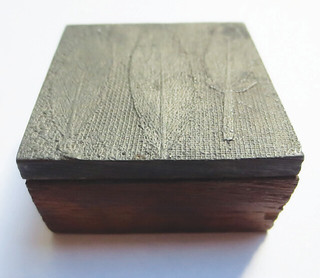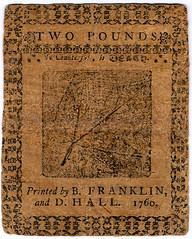
PREV ARTICLE
NEXT ARTICLE
FULL ISSUE
PREV FULL ISSUE
BEN FRANKLIN'S NATURE PRINTING BLOCKS DISCOVEREDWe missed this one last week! On December 12, 2014 Fine Books Magazine published an article on an amazing discovery in the
vaults of the Delaware Country Institute of Science. -Editor
Among the most intriguing of all early American graphics are the delicate images of leaves used as a counterfeit deterrent on paper money printed by Franklin and his successors from 1737 to 1785. Experts believed they were made by pressing a leaf into plaster and making a mold of the impression that could then be used to cast printing blocks from type metal. This was guesswork, however, as the process was highly secret, and none of the blocks was known to have survived—until now. It is very rare to find examples of early American metal type, as it was normally melted down when it wore out. Type-metal blocks used to print pictures and ornaments are even rarer.
Using some very high resolution digital photography, and matching the blocks to currency in the collections of Winterthur and the American Antiquarian Society, as well as that from DCIS, Linker and Green determined that all the blocks were—in fact—cast, making possible some of their more intricate devices, such as variable surface height so that some low-relief areas print as gray—rather than the firm black of the higher relief elements and the white of recessed areas—and cross-hatching scored into the lead after casting. All these variously complicated techniques were meant to further deter counterfeiters, on the assumption that printers trained in the normal way would not have known how to replicate them. They were effective precisely because they were made in unconventional ways. Given the date of currency printed with the leaf block, issued by the province of Delaware in 1760, this particular block was almost certainly cast not by Franklin but by his successor David Hall. Nonetheless, these blocks may be the earliest surviving pieces of type metal cast from molds made in America. The Delaware County Institute of Science has graciously agreed to place these materials on long-term deposit at the Library Company, and we anticipate that more investigation will yield more discoveries. For illustration purposes, I added an image of a 1760 Delaware note from the Notre Dame colonial currency site. I also reached out
to colonial currency researcher Eric P. Newman for comment. -Editor
Eric Newman writes: "Very interesting. I'll have to study it further to see how it dovetails with my previous writing on the subject of Franklin's development of nature printing." I wasn't able to quickly locate images of notes that visibly match the printing plates, but I'll look forward to future
articles exploring this connection. What a marvelous find! Who will be the first E-Sylum reader to visit the Library Company and view the
blocks in person? -Editor
For more on Delaware 1760 currency, see:
To read the complete article, see:
Wayne Homren, Editor The Numismatic Bibliomania Society is a non-profit organization promoting numismatic literature. See our web site at coinbooks.org. To submit items for publication in The E-Sylum, write to the Editor at this address: whomren@gmail.com To subscribe go to: https://my.binhost.com/lists/listinfo/esylum All Rights Reserved. NBS Home Page Contact the NBS webmaster 
|

